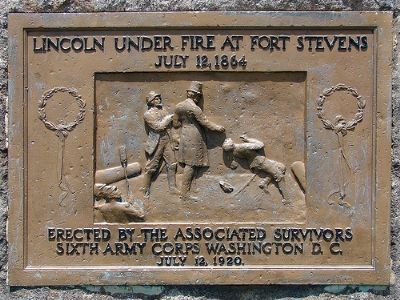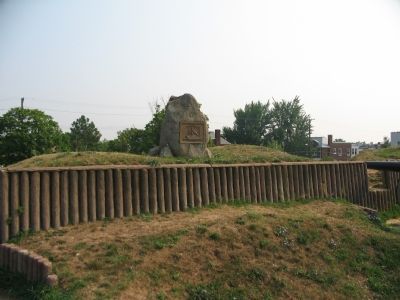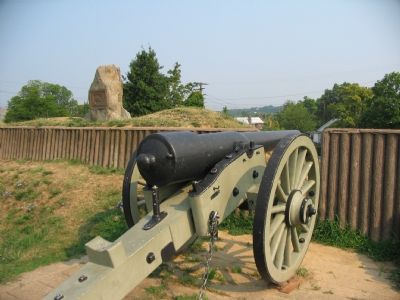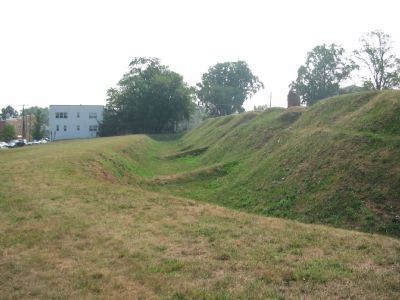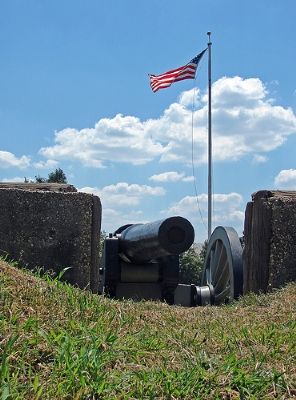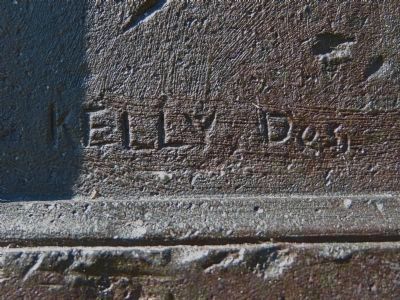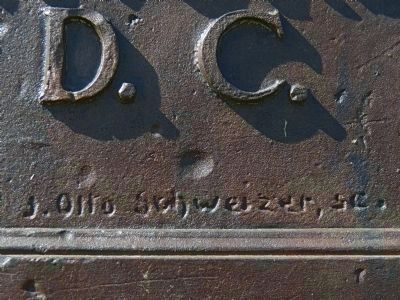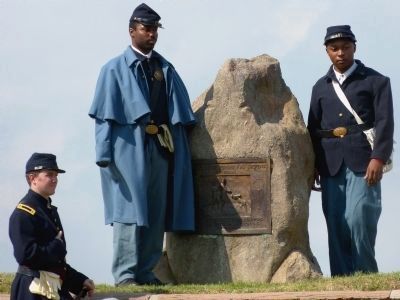Brightwood in Northwest Washington in Washington, District of Columbia — The American Northeast (Mid-Atlantic)
Lincoln Under Fire at Fort Stevens
July 12, 1864
Erected 1920 by The Associated Survivors Sixth Army Corps, Washington, D.C.
Topics and series. This historical marker is listed in these topic lists: Forts and Castles • Government & Politics • War, US Civil. In addition, it is included in the Defenses of Washington, and the Former U.S. Presidents: #16 Abraham Lincoln series lists. A significant historical date for this entry is July 12, 1979.
Location. 38° 57.871′ N, 77° 1.748′ W. Marker is in Northwest Washington in Washington, District of Columbia. It is in Brightwood. Marker can be reached from 13th Street Northwest north of Fort Stevens Drive Northwest, on the right when traveling north. It is located within the reconstructed Fort Stevens just to the north of the flag pole. Touch for map. Marker is at or near this postal address: 6001 13th Street Northwest, Washington DC 20011, United States of America. Touch for directions.
Other nearby markers. At least 8 other markers are within walking distance of this marker. Scale Model of Fort Stevens (a few steps from this marker); Fort Stevens (a few steps from this marker); a different marker also named Fort Stevens (about 300 feet away, measured in a direct line); “Get Down You Fool” (about 300 feet away); Aunt Betty's Story (about 400 feet away); The Rock on Brightwood Avenue (about 400 feet away); A Streetcar Named Brightwood (about 800 feet away); St. John United Baptist Church (approx. 0.2 miles away). Touch for a list and map of all markers in Northwest Washington.
Regarding Lincoln Under Fire at Fort Stevens. Fort Stevens was one of the ring of forts that defended Washington during the Civil War. President Abraham Lincoln came out from the city to Fort Stevens to watch the VI Army Corps repulse the Confederates, who were under the command of Lt. Gen. Jubal A. Early. This fight was the closest Confederates got to Washington during the War Between the States. Lincoln himself came under fire from Confederate sharpshooters. The bas-relief on this marker depicts this close call.
Also see . . . The War Effort: Fort Stevens. Mr. Lincoln’s White House website entry (Submitted on March 21, 2007.)
Additional commentary.
1. Sharpshooters firing on Lincoln
On the grounds of Walter Reed Army Medical Center is a plaque which claims to be the site of a “Sharpshooter’s Tree.” Legend has it a very tall tulip tree afforded several Confederates cover from which to fire upon the Fort Stevens works, in particular President Lincoln, who insisted on observing the fighting over the protests of the officers present.
— Submitted August 5, 2007, by Craig Swain of Leesburg, Virginia.
2. General Jubal Early’s comments
The Confederate commander, General Jubal Early, recognized Fort Stevens was too strong for his forces to break and retreated the next day. To his staff, he remarked, “We didn’t take Washington, but we scared Abe Lincoln like hell.”
— Submitted August 5, 2007, by Craig Swain of Leesburg, Virginia.
3. The Young Oliver Wendell Holmes and President Lincoln
One of the vignettes often told concerning Fort Stevens centers upon Lincoln's visit while the Confederates were skirmishing in front of the earthworks. The story goes that President Lincoln was so taken by the scene of battle he stood upon the parapet of the fort, with trademark stovepipe hat, while Confederate sharpshooters were firing upon the soldiers in the fort. Lincoln seemed oblivious to the danger, even as several men nearby were hit by enemy fire. A young Captain Oliver Wendell Holmes finally
exclaimed, "Get down, you fool!" Lincoln soon obliged, but later commented to the future Supreme Court Justice, "It is good to see you know how to talk to civilians." The full accuracy of the story is open for some debate, but is presented and annotated on Mr. Lincoln's White House Website (see links). Note To Editor only visible by Contributor and editor
— Submitted October 14, 2007, by Craig Swain of Leesburg, Virginia.
4. Dedication of Lincoln Under Fire Boulder
The boulder marking the spot where Lincoln stood (not the plaque which came later) was dedicated on November 7, 1911. At that dedication ceremony, Louisiana congressman Floyd King, who had been an artillerist serving with General Early, spoke. He went to lengths to praise the work of President Lincoln, going to the point of stating he was glad the Confederate attack had failed. Certainly an interesting perspective coming from a Confederate veteran.
— Submitted October 17, 2007, by Craig Swain of Leesburg, Virginia.
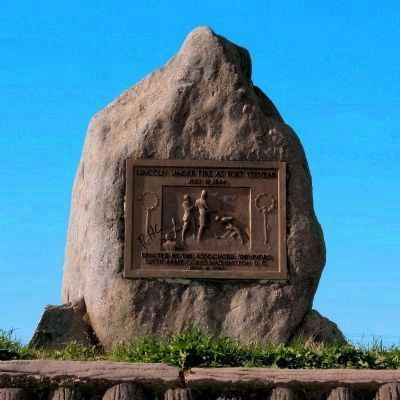
Photographed By Allen C. Browne, April 16, 2008
4. Lincoln Under Fire at Fort Stevens Marker
The Lincoln Boulder was set up by the Associated Survivors of the Sixth Army Corps in 1911. The bronze plaque containing a bas-relief of Lincoln under fire at Fort Stevens by Otto Schweizer and James Kelly was dedicated on July 12, 1920.
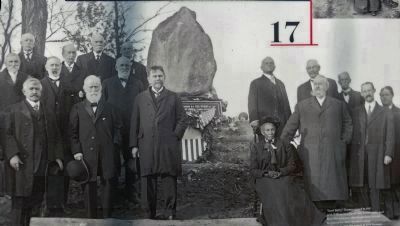
1911
9. 1911 Dedication of the Lincoln Boulder
"Aunt Betty" Thomas posed in 1911 with William Van Zandt Cox, to her right and Civil War veterans who funded the Lincoln Memorial Boulder, the first marker commemorating the events of Fort Stevens. (Photo from the nearby "Aunt Betty's Story" marker.) The plaque on the boulder that preceded the 1920 Kelly/Schweizer bas-relief plaque indicated that this was the site General Wright identified as the spot where Lincoln stood exposed to enemy fire.
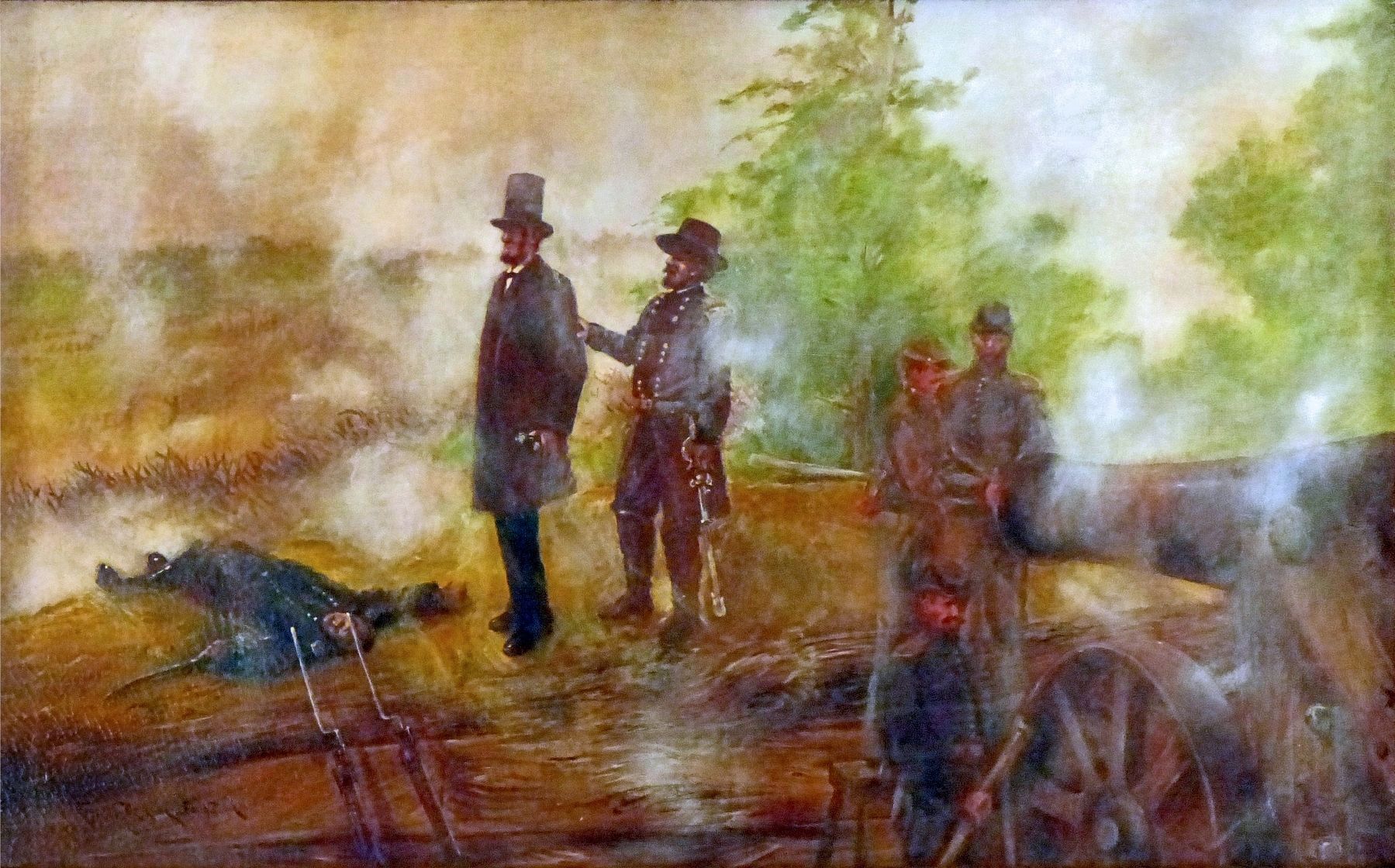
Photographed By Allen C. Browne, June 6, 2017
11. Abraham Lincoln at the Battle of Fort Stevens
This c. 1892 painting by Eugenie De Land Saugstad hangs in the superintendent's lodge at the Battleground National Cemetery. “President Lincoln is shown visiting Fort Stevens during the battle on July 12, 1864 as he comes under enemy fire while standing on the parapet.… The painting was donated by the artist to the Lincoln Museum which became Ford's Theatre National Historic Site.” — NPS
Credits. This page was last revised on January 30, 2023. It was originally submitted on March 21, 2007, by Steve Fernie of Arlington, Virginia. This page has been viewed 6,043 times since then and 72 times this year. It was the Marker of the Week October 14, 2007. Photos: 1. submitted on March 21, 2007, by Steve Fernie of Arlington, Virginia. 2. submitted on August 5, 2007, by Craig Swain of Leesburg, Virginia. 3. submitted on October 17, 2007, by Craig Swain of Leesburg, Virginia. 4. submitted on May 1, 2013, by Allen C. Browne of Silver Spring, Maryland. 5. submitted on August 5, 2007, by Craig Swain of Leesburg, Virginia. 6. submitted on March 21, 2007, by Steve Fernie of Arlington, Virginia. 7, 8. submitted on May 2, 2013, by Allen C. Browne of Silver Spring, Maryland. 9, 10. submitted on April 28, 2013, by Allen C. Browne of Silver Spring, Maryland. 11. submitted on June 19, 2017, by Allen C. Browne of Silver Spring, Maryland. • J. J. Prats was the editor who published this page.
